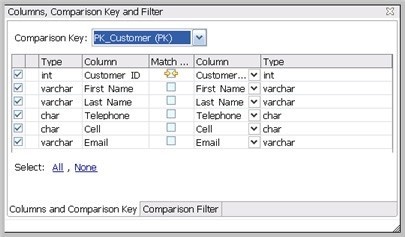Page History
...
- Type a new name for the job in the Name field. Enter a meaningful name that will quickly and uniquely identify the job in other views and dialogs.
- Add relevant information in the Notes field.
- Click Track Results in Compliance Explorer if you want the job to be listed in the Compliance Explorer. Compliance is used most commonly for configuration comparisons.
- Click File > Save or File > Save All, or highlight the editor window and press Ctrl+S.
...
- Select a row by highlighting it with the cursor. (The check box is irrelevant for this task.)
- On the right side of the pane, click View Column Mapping.
- In the Columns and Comparison Key pane, you can:
- Select or deselect columns to use in the comparison job. Because this could affect referential integrity, review Resolution Options.
- Change or add a comparison key if multiple keys are available. In the Comparison Filter pane, you can:
- Write a WHERE
- clause to use during the comparison.
Create a different WHERE clause per table in the pair. Select Separate Where Clause and an additional text box is added for a second WHERE clause.
Info When entering selective WHERE clauses, do not include the WHERE keyword; for example, use “AGE>12” instead of “WHERE AGE>12”.
Reconfigure the Data Source Mapping
After configuring and running a comparison job, you may discover that you need to set different mapping options. You can reconfigure the way DB Change Manager maps data source elements and then run the job again.
To reconfigure the automatic mapping process
In the Options tab, select or deselect Mapping Options. The options are also described in Mapping Options.
If you change the mapping options in Preferences, they will become the defaults for all new jobs.
In the Mapping tab, click Refresh Databases and Owners to update the automatic comparison.
Set Job Notification Options
When a job completes, DB Change Manager provides various ways of notifying you. See Setting Job Notifications for details.
Run the Data Comparison Job
After you have specified the options and mappings for a data comparison job, you can run it.
To run a job
Click File > Save to save the job before you run it.
In the upper right of the Data Comparison Job editor, click the Run icon.
While the process runs, the Results tab appears and displays the Comparison Summary pane. This information includes:
Source and target data source names
When the job started
Estimated remaining time for the job to run
Elapsed time of the job
The names of objects currently being compared
A progress bar showing percentage completion
Review Comparison Results
After a job run completes, the Results tab shows the Comparison Results table.
The Comparison Results table lists:
The source and target databases
Progress status; either Done, Failed, or, if no pairs were specified, Nothing to Compare
The Compare Index percentage of matches
The Results column View icon links to details about the comparison job
After running a data comparison job, you may decide to synchronize one to the other. For more information, see Synchronizing Data Repositories.
